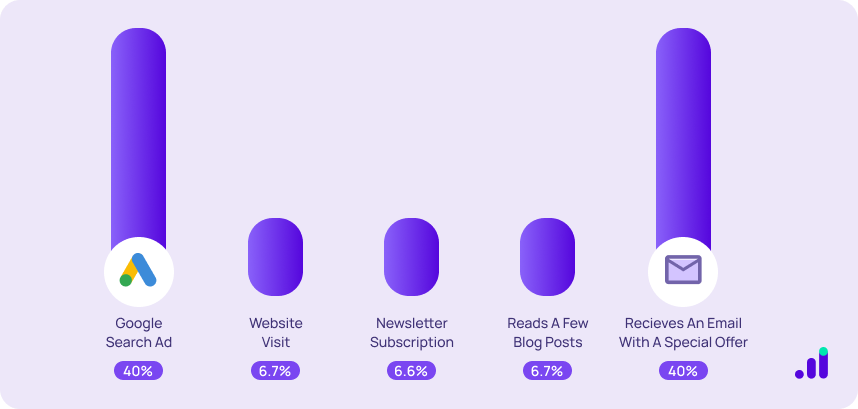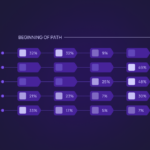
In today’s multi-channel marketing landscape, every customer journey is a story – and knowing which touchpoints truly drive conversions can make or break your ROI. That’s where the Position-Based Attribution Model steps in. Also known as the U-Shaped model, it strikes the perfect balance by giving the most credit to the first and last interactions – the moments that spark interest and seal the deal – while still recognizing the supporting touchpoints in between.
This model bridges the gap between discovery and conversion, offering marketers a more realistic picture of how different channels work together. However, to get the full story, it’s crucial to understand its strengths, limitations, and when to use it. Mastering the Position-Based Attribution Model empowers you to allocate budgets smarter, fine-tune campaigns, and unlock a more accurate view of your marketing performance.
Jump ahead to:
What is the Position-Based Attribution Model?
The Position-Based Attribution Model, also known as the U-shaped attribution Model, is a method used in digital marketing to assign credit for conversions to various marketing interactions. This model emphasizes the importance of both the initial and final interactions in the customer journey, while also acknowledging the contribution of intermediate interactions. Typically, 40% of the credit goes to the first interaction, which initiates the customer journey, and 40% to the last interaction, which leads to the conversion. The remaining 20% of the credit is distributed equally among the intermediate interactions.

How Does the Position-Based Attribution Model Work?
The position-based attribution model is designed to highlight the value of both the introduction and the final push in a customer’s decision-making journey. Rather than focusing entirely on a single touchpoint, it spreads credit across different interactions in a structured way, making it especially useful for marketers who want a balanced view of how campaigns work together.
Here’s how it functions:
1. Mapping the Customer Journey
The process begins by identifying all the touchpoints where a potential customer engages with your brand. These touchpoints could be a display ad, a social media click, a Google search, an email open, or any other interaction that leads the customer closer to conversion.
2. Giving Weight to Key Interactions
Once the journey is mapped, the model assigns conversion credit in a U-shaped pattern:
- First Interaction (Awareness): The initial touchpoint – like a paid ad or blog post – that introduces your brand gets 40% of the credit. This acknowledges the importance of sparking awareness.
- Last Interaction (Conversion Trigger): The final touchpoint – such as clicking on a retargeting ad or branded search before making a purchase – also receives 40% of the credit. This highlights the moment that tipped the customer into converting.
- Middle Interactions (Nurturing Phase): The remaining 20% is shared across all interactions in between. These represent the nurturing phase where the customer gains trust, researches alternatives, and builds intent to purchase.
Use Cases of Position of position based Attribution model
E-commerce Store
Imagine you run an online clothing store.
- A shopper first discovers your brand by clicking on a Facebook ad showcasing your new collection.
- Later, they browse your products again through a Google Display remarketing ad.
- They then open a promotional email about seasonal discounts.
- Finally, they complete their purchase after clicking on a Google Search ad for “best summer dresses online.”
With position-based attribution:
- Facebook ad (first touch) → 40% credit
- Google Search ad (last touch) → 40% credit
- Google Display ad + Email → each gets 10% credit
This ensures you’re valuing both brand discovery and conversion, while also acknowledging nurturing channels.
SaaS Business
Let’s say you run a SaaS company offering a project management tool.
- A potential customer first finds you through a LinkedIn ad about productivity.
- They later download an ebook on your website.
- Next, they attend a webinar hosted by your team.
- Finally, they sign up for a free trial after clicking on a retargeting Google Search ad.
With position-based attribution:
- LinkedIn ad (awareness) → 40% credit
- Google Search retargeting ad (conversion) → 40% credit
- Ebook download + Webinar → each gets 10% credit
This model highlights both the awareness stage (LinkedIn ad) and the final push (Google Search ad), while recognizing the nurturing role of your content.
Advantages of the Position-Based Attribution Model for Marketers
The position-based attribution model offers several advantages for marketers, especially when it comes to understanding the complete customer journey and giving credit to crucial touchpoints. Here are some of the key benefits:
- Balanced Insight: Provides a comprehensive view of the customer journey by giving significant credit to both the first and last interactions, which are crucial for initiating and completing the conversion process.
- Optimizes for Full-Funnel Marketing: Helps in optimizing marketing efforts across the entire funnel, from brand awareness to the final conversion, enhancing the effectiveness of overall marketing strategies.
- Improved Resource Allocation: By understanding the contribution of different interactions, marketers can allocate resources more effectively across various channels and tactics.
Disadvantages of the Position-Based Attribution Model
While the position-based attribution model offers a more balanced view of the customer journey, it has some limitations to consider. Here are some of the disadvantages to be aware of:
- Complexity: More complex to implement and analyze compared to simpler models like Last-Click or First-Click attribution, requiring advanced tracking and analytics capabilities.
- Potential Overemphasis: May overemphasize the importance of the first and last interactions, potentially undervaluing some critical middle interactions that contribute significantly to nurturing leads.
- Less Effective for Short Journeys: May not be as effective for short customer journeys with fewer interactions, where other models like Last-Click might provide clearer insights.
- Data Requirements: Requires comprehensive and accurate data collection across all interactions, which can be challenging for businesses with limited analytics infrastructure.
Best Practices for Using the Position-Based Attribution Model
Here are some best practices to get the most out of the Position-Based Attribution Model:
- Combine with Other Models: Use in conjunction with other attribution models, such as Time Decay or Linear Attribution, to gain a more holistic view of the customer journey and validate insights.
- Leverage Advanced Analytics Tools: Utilize advanced analytics and attribution tools to accurately track, analyze, and visualize data from all interactions, ensuring precise attribution. For example:
- Google Analytics: Offers comprehensive tracking and reporting capabilities.
- Adobe Analytics: Provides in-depth analysis and data visualization.
- Attribution Software: Tools like EasyInsights integrate various data sources for precise attribution.
- Integrate Across Channels: Ensure that the model integrates data from all marketing channels, including online and offline interactions, for a comprehensive view of the customer journey.
- Use for Comprehensive Campaigns: This model is particularly effective for campaigns designed to engage customers throughout the entire journey, from awareness to conversion.
- Focus on High-Impact interactions: Identify and prioritize high-impact interactions that significantly influence conversions, ensuring that both the first and last interactions, as well as key middle interactions, are optimized.
When to Use the Position-Based Attribution Model
The position-based attribution model shines in specific scenarios where understanding the influence of both initial awareness and final touchpoints is crucial. Here are some key situations where it can be a good choice:
- Brand Awareness and Conversion Focus: When your marketing strategy aims to build brand awareness and drive conversions, this model helps balance credit between initial awareness efforts and final conversion actions. Example A brand awareness campaign might involve display ads and social media posts that lead to email marketing and eventually a purchase.
- Long Purchase Decision Process: When the purchase decision process is extended and involves multiple stages of consideration and evaluation, this model ensures all stages are appropriately valued. Example: A customer might first interact with your brand via an SEO article, sign up for a webinar, download a whitepaper, and then make a purchase after a consultation call.
- Complex Sales Cycles: If your business involves a complex sales cycle with multiple interactions, such as in B2B or high-value consumer purchases, this model helps identify the importance of various interactions. Example: A customer might discover your brand through an online ad, research further through blog posts and webinars, and finally convert through a direct sales interaction.
- Omnichannel Marketing: For businesses running integrated marketing campaigns across multiple channels (e.g., social media, email, PPC, content marketing), the Position-Based model helps attribute value to different channels. Example: A campaign that starts with a social media ad, followed by email nurturing, and ends with a direct purchase from a website link.
Additional Reading: Comparing Attribution Models in Google Analytics 4 (GA4)
How EasyInsights Enhances Position-Based Attribution
EasyInsights enhances Position-Based Attribution by giving you full visibility into the entire customer journey – from the first touch to the final conversion.
Through server-side tracking, EasyInsights ensures that all key interactions are captured accurately, even in environments where traditional tracking fails.
It connects data from multiple ad platforms, CRM, and analytics tools to build a holistic view of every touchpoint, allowing marketers to assign credit precisely between top-of-funnel and bottom-of-funnel interactions.
By leveraging first-party data activation, EasyInsights helps you identify which entry points and closing interactions truly drive results – optimizing spend and improving campaign efficiency across all channels.
Additional reading: Activate your First Party data to increase your ROAS for ecommerce
Conclusion
The Position-Based Attribution Model offers a balanced approach to understanding the customer journey by emphasizing the importance of both the initial and final interactions while also recognizing the role of intermediate touchpoints. By leveraging this model, marketers can gain valuable insights into how different interactions contribute to conversions and optimize their campaigns accordingly. Effective attribution requires accurate and comprehensive data to function properly.
EasyInsights provides a reliable solution for attribution challenges by leveraging server-side tracking to gather first-party data. With detailed insights and robust analytics, EasyInsights can help you implement the right attribution strategy for your marketing efforts.
To know more, book a demo today!








